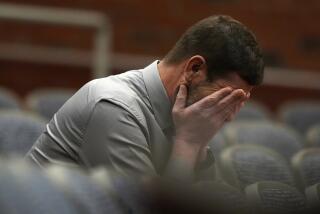Padilla jury sees video of Bin Laden
Jurors hearing the case against terrorism suspect Jose Padilla on Tuesday watched a 10-year-old CNN video in which Osama bin Laden denounced the United States as tyrannical and vowed to send “messages without words” to then-President Bill Clinton.
That chilling harbinger of the Sept. 11, 2001, terrorist attacks compounded, at least emotionally, government evidence and expert testimony linking Padilla’s two codefendants to top Al Qaeda figures and deadly violence in Somalia, Bosnia and Chechnya.
In the first evidence in the 7-week-old trial suggesting that they shared Bin Laden’s radical ideology, Kifah Wael Jayyousi and Adham Amin Hassoun were heard on wiretapped phone calls praising Bin Laden for his defiance of U.S. policy in the Muslim world.
“May Allah protect him,” Hassoun, a Lebanese-born Palestinian, is heard saying after the Al Qaeda leader’s CNN interview. Jayyousi, a naturalized U.S. citizen born in Jordan, praised Bin Laden’s televised message as “quite powerful.”
Jurors watched with rapt attention as the video, edited from 20 minutes to seven to delete editorial commentary, played on a large screen in U.S. District Judge Marcia G. Cooke’s courtroom. The jurors betrayed no emotion as Bin Laden hailed terrorist bombings that killed U.S. troops in his native Saudi Arabia and warned American civilians to get out of sacred Muslim territories or face the same fate.
In his parting comment in the 1997 video, Bin Laden said Clinton’s name evoked his “disgust” and that “our people in Arabia will send him messages without words, because he does not understand words.”
Cooke told the jury before and after the interview was played that the defendants weren’t on trial for any involvement in the Sept. 11 hijackings that killed nearly 3,000 at the World Trade Center, the Pentagon and in a fiery crash in Pennsylvania.
The clip was shown only to help them determine the “state of mind” of Jayyousi and Hassoun, Padilla’s alleged recruiters, at the time they were alleged to be running a North American terrorist support cell.
She added that the Bin Laden interview shouldn’t be considered in judging Padilla because there was no evidence he ever saw, heard or discussed it.
All three defendants are charged with conspiracy to murder, maim or kidnap persons abroad and with providing material support to terrorist groups. Their lawyers have argued that the men sought to help fellow Muslims under siege in the global hotspots of the 1990s.
Defense attorneys argued against playing the CNN video, calling the images of the world’s most wanted man inflammatory, prejudicial and irrelevant because the defendants weren’t charged with threatening U.S. citizens or territory.
Despite Cooke’s caution to the jury that the trial doesn’t involve Sept. 11, veteran trial consultant Philip K. Anthony said the video likely had a profound effect on the jury.
“Typically in most jurors’ minds there is some sense that the video would not have been allowed to be shown unless there was some good reason for doing so,” said Anthony, head of DecisionQuest in Los Angeles. “Presenting what most Americans would view as emotional footage of Bin Laden saying what he’s going to do to America ... I think more often than not that produces a sense of guilt by association.”
After the video was played, a prosecution expert witness testified that the groups supported by Hassoun and Jayyousi were part of a militant Islamic network headed by Al Qaeda and committed to forcibly establishing fundamentalist regimes wherever Muslims lived.
In a May 11, 1997, wiretapped conversation in which Hassoun and Jayyousi excitedly discussed the CNN interview, Hassoun referred to Bin Laden as Abu Abdullah. That name is used only among close associates and admirers of the Al Qaeda leader, said Rohan Gunaratna, founder of the International Centre for Political Violence and Terrorism Research in Singapore.
A Sri Lankan scholar who teaches at West Point, Gunaratna tied Bin Laden and Al Qaeda to the conflict areas to which Hassoun and Jayyousi were alleged to have dispatched recruits from the United States and Canada over the decade they were under surveillance.
While testimony in recent days has cast the two alleged cell leaders as more deeply involved with radical groups in the far-flung war zones than previously indicated, the evidence has shed little light on what role Padilla might have played.
His voice is heard in only eight of more than 300,000 conversations that U.S. intelligence agents intercepted between 1993 and 2001. None of the calls involving Padilla, played weeks ago, contained any incriminating discussion other than his occasional use of cryptic language.
Jayyousi and Hassoun came to U.S. intelligence attention in 1993, after they publicly expressed support for Sheik Omar Abdul Rahman, a radical Islamic scholar. An Egyptian revered by many militant Islamists as their spiritual leader, Rahman is serving a life sentence in the 1993 bombing of the World Trade Center.
After his arrest at Chicago’s O’Hare International Airport in May 2002, Padilla was accused by the Bush administration of plotting to detonate a radioactive “dirty bomb” in an unspecified U.S. city. President Bush branded him an enemy combatant and he was held in isolation in a brig in South Carolina for 3 1/2 years. Since his transfer to the civilian court system and January 2006 indictment along with Hassoun and Jayyousi, there has been no mention of a bomb plot.
More to Read
Start your day right
Sign up for Essential California for news, features and recommendations from the L.A. Times and beyond in your inbox six days a week.
You may occasionally receive promotional content from the Los Angeles Times.







